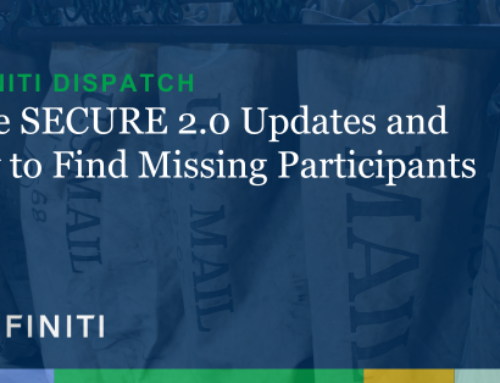On December 20, 2019, President Trump signed the SECURE Act into law, bringing the most sweeping retirement plan legislative changes in over a decade. Many of the provisions apply to new plans, but a substantial number of changes affect current plan operations. Our national team of retirement plan administrators are continuously evaluating how these changes may benefit new plans, and how existing plans should adapt these changes. We’ve compiled a quick list below of the provisions we’re watching.
Unless specified otherwise, the provisions discussed below will apply to plan years and taxable years beginning after December 31, 2019. Amendments for these provisions will not be due until the last day of the plan year beginning on or after January 1, 2022.
Beneficial Provisions
Increased Tax Credits for Small Employers with New Plans
The SECURE Act increases the tax credit for small employers (with fewer than 100 employees in the preceding tax year) from $500 up to $5,000. This tax credit applies to the first 3 years following the adoption of a new plan. The tax credit will equal 50% of the plan’s start-up costs up to the greater of (a) $500 or (b) the lesser of (i) $250 for each eligible non-highly compensated employee, or (ii) $5,000, per year. Small businesses that have not yet implemented a 401(k) plan may want to consider if it’s time to start a plan and benefit from these tax credits.
Additional Tax Credit for Automatic Enrollment
One other item to note regarding tax credits: small employers may receive an additional tax credit of $500 per year for 3 years starting in the year in which automatic enrollment provisions are effective, either as a new provision in an existing plan or in a newly adopted plan.
Simplification of Safe Harbor Rules
Safe harbor plans come in two variations: the 3% nonelective safe harbor and the safe harbor match. The new SECURE Act eliminates the notice requirement for the 3% nonelective safe harbor, but the notice requirement for the safe harbor match remains. Employers maintaining a non-safe harbor plan may also amend their plan to include the 3% nonelective safe harbor provision up to 30 days before the close of the plan year. Such sponsors can even amend their plan to be safe harbor, up until the last day of the following plan year, but the nonelective safe harbor percentage increases from 3% to 4%.
Allowing Long Term Part-Time Workers to Participate in 401(k) Plans
This provision includes some complexity. Under pre-existing law, employers may exclude part-time employees who work less than 1000 hours per year. The SECURE Act requires, for employers maintaining a 401(k) plan, that any part-time employee who has not met the plan’s eligibility provisions be permitted to make elective deferrals to the plan if the employee is at least age 21, has completed 3 consecutive years of service and is credited with at least 500 hours of service during each of those years. So long as these employees remain below 1,000 hours, no employer contribution (including top heavy and gateway minimums) would be required until the employee meets the plan’s eligibility provisions. In addition, employers may exclude such employees from nondiscrimination and coverage testing. This could impact plans that are nearing audit size (the 100/120 participant rule). The good news is, due to the service crediting rules under this new provision, the earliest this will apply is 2024.
Retroactive Effective Dates for Plan Adoption
The SECURE Act provides the opportunity for employers to adopt a new plan for the prior tax year up to the due date of their company tax return, including extensions. Note, however, this provision will not apply to 401(k) provisions in the plan, as such provisions must be in place before the plan can accept elective deferrals.
Changes to Watch
Increased Penalties
OUCH! The Form 5500 penalty for late filing has increased to $250 per day, not to exceed $150,000. Failure to provide a required withholding notice is increased to $100 for each failure, not to exceed $50,000 for all failures during a calendar year. Other fines are going up as well. File timely and be diligent with all the required forms and notices!
Increase in Beginning Date for Required Minimum Distributions
Under current regulations, participants are generally required to begin taking distributions from their retirement plan at age 70½. The SECURE Act moves the required minimum distribution age to 72 for those who attain age 70½ after December 31, 2019. Important Note: Qualified plan (not IRA) participants, who are not 5% owners, can delay distributions until the year in which they separate from service.
Repeal of Maximum Age for Traditional IRA Contributions
Although not applicable for qualified plans, individuals may now continue to make IRA contributions regardless of their age. Individuals over age 70½ may make an IRA contribution for 2020 and subsequent tax years.
There are many other provisions in the Act. We picked just a few that may have the biggest impact. As always, if you have questions about what the SECURE Act means for you, or your plan, contact your plan administrator.
*If you’re one of the 60% of the small businesses in America that do not yet offer a 401(k), now may be a good time to consider implementing one. Contact us for details.





